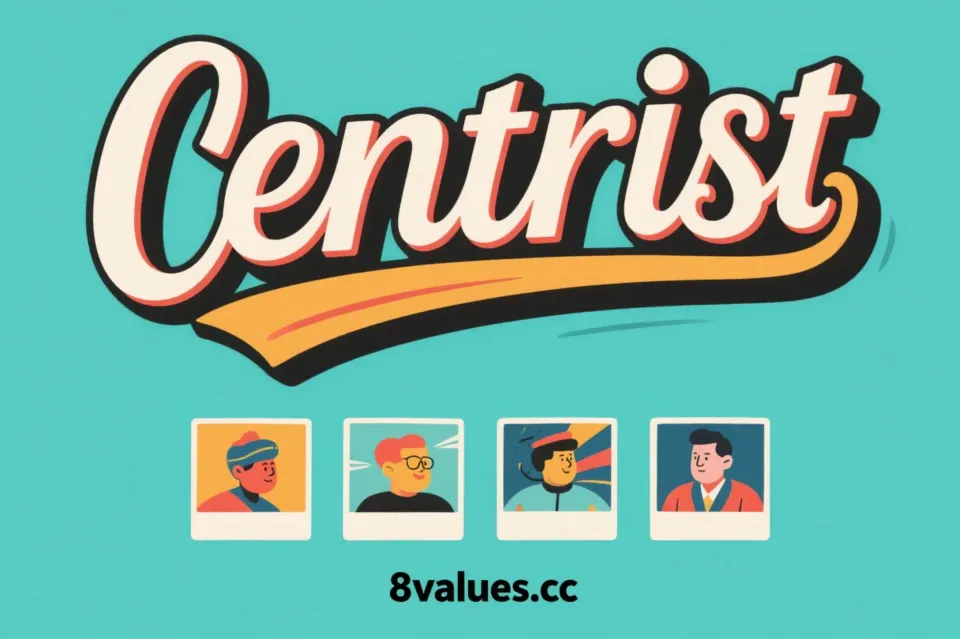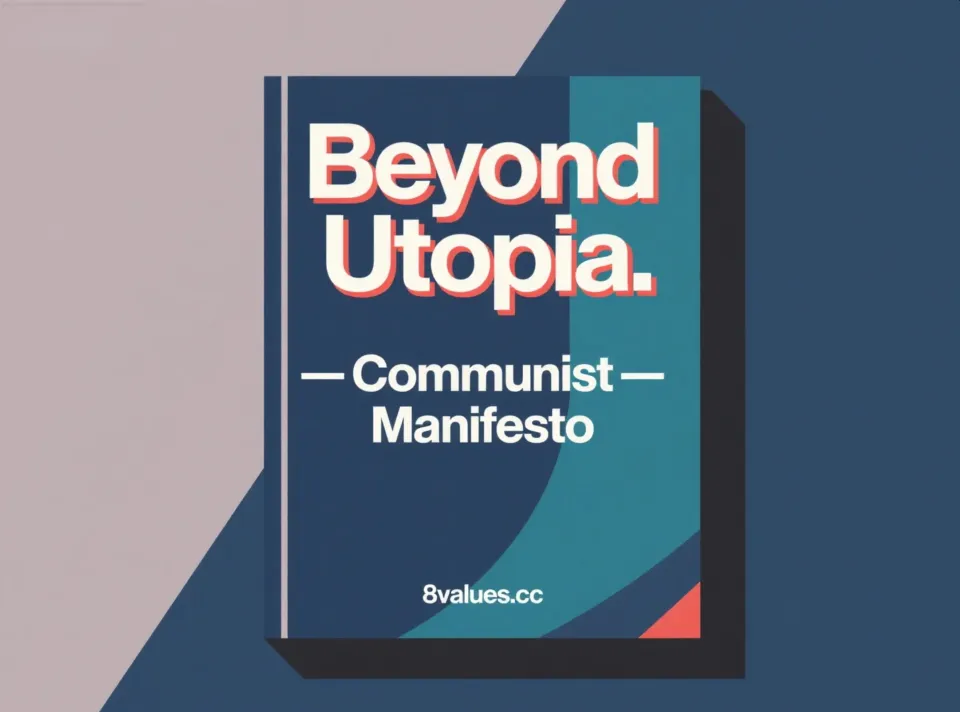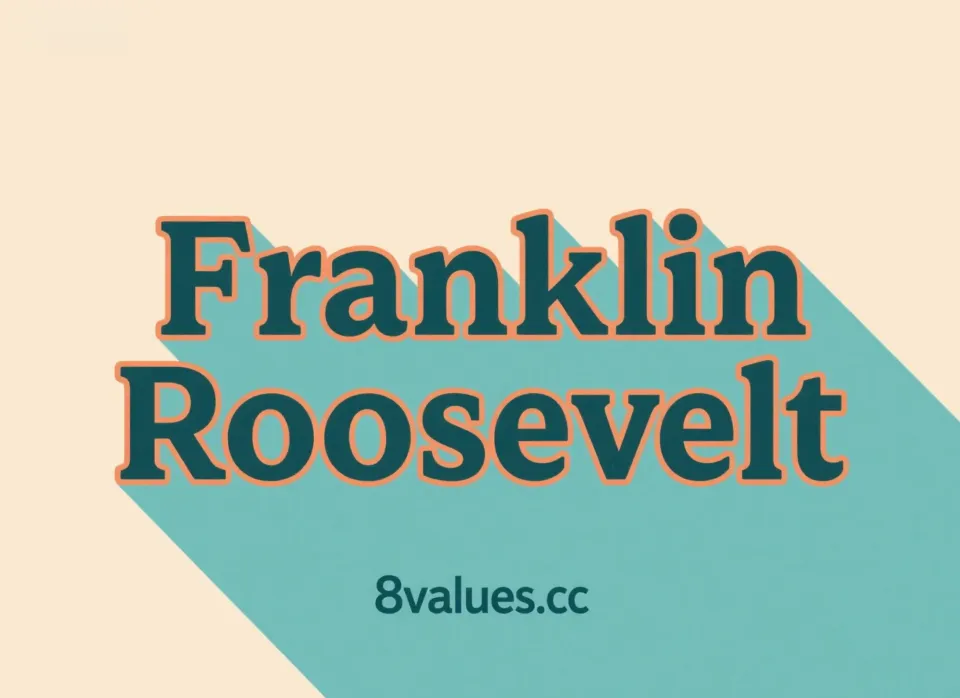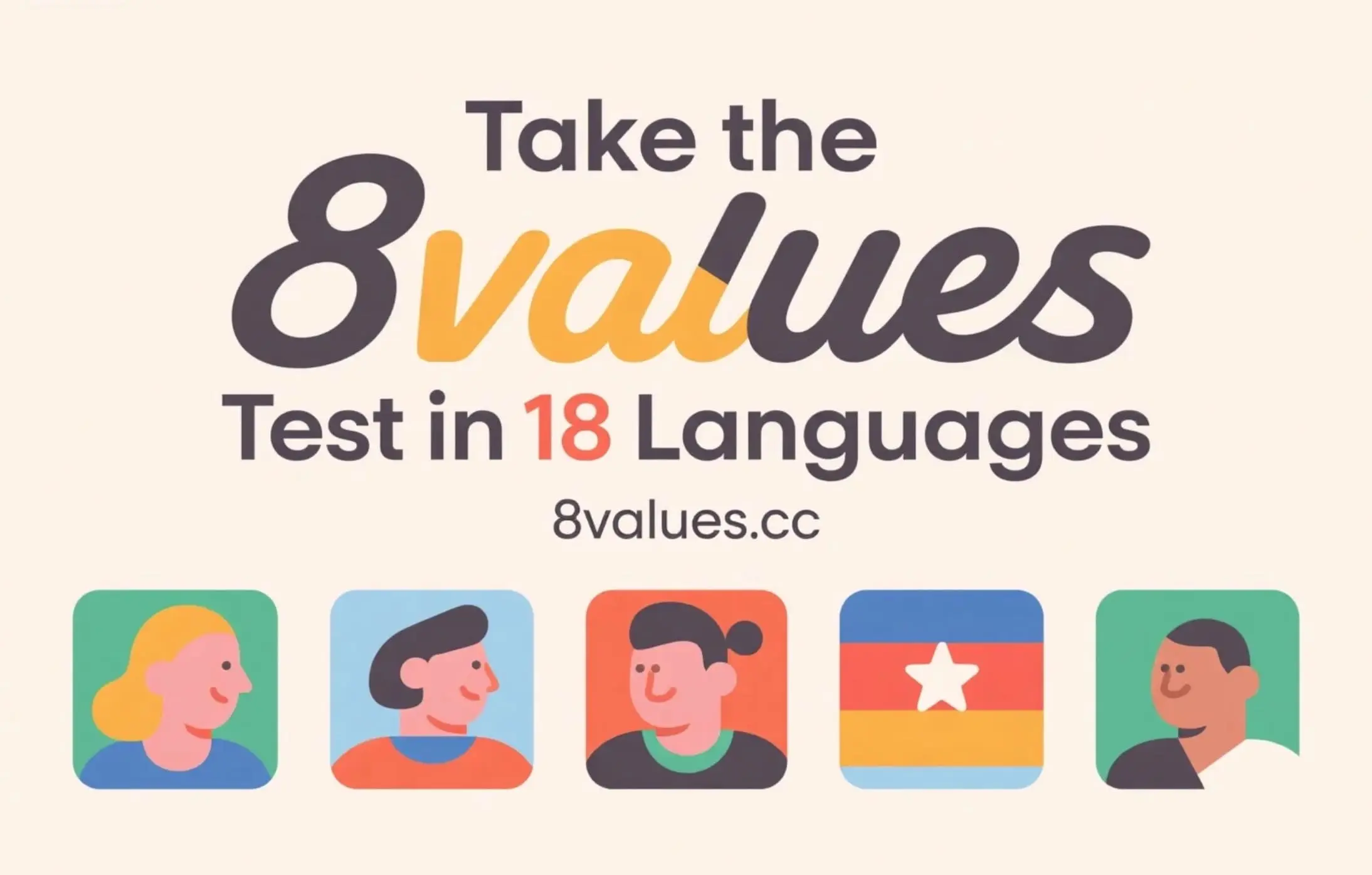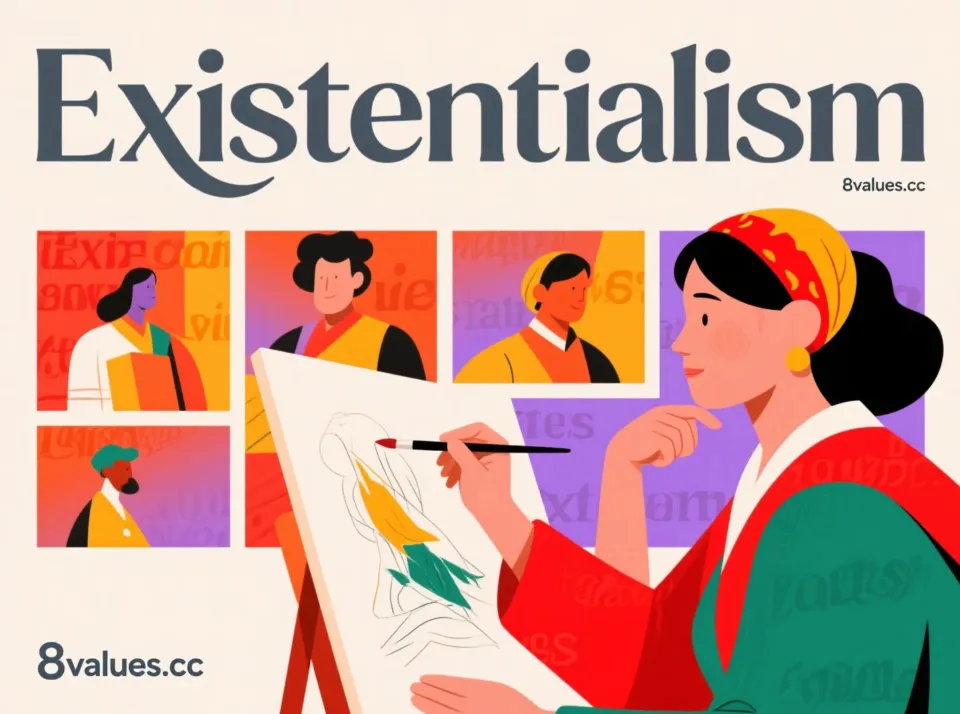Centrist | 8values Interpretation of ideological ideology of political test
This article deeply analyzes the centrists and centrists in the 8 values test results, understanding their position in the political spectrum, core principles, historical evolution, different types, challenges faced, and their impact on democratic politics. Based on the perspective of 8values political testing, it provides comprehensive and profound analysis to help users better understand this complex political concept.
In today's highly polarized world, political discussions are often filled with fierce opposition and conflict. However, outside the hustle and bustle of the left and right wings, there is a political stance dedicated to balance, pragmatism and compromise—that is, Centrist and Centrism . It is not only a "geographical midpoint" in the political spectrum, but also a unique political philosophy and methodology.
To better understand one's place in the political spectrum, many people will seek help from political tests. For example, the 8values Political tendency ideological test is a popular tool that helps you understand your ideological tendencies through a series of questions and locates them on the coordinates of the political spectrum, ultimately providing a detailed introduction to 52 ideological results. This article will focus on the test results of "centricism" and explore all aspects in depth.
The definition and core principles of centrist
Centivism is a political approach designed to find a balance between the left and right wings. It is often associated with moderate politics, including both those who firmly support moderate policies and those who do not have strong left or right positions.
The core philosophy of the centrist is not simply averaging between extremes, nor is it a political "lucky or hot" or maintaining the status quo. Instead, it is considered a more radical stance.
The core values and principles of centrists include:
- Pragmatism and Balance : Centres prioritize practical solutions over rigid ideology. They blend ideas from both sides, seeking pragmatic and inclusive solutions, believing that no extreme stance can provide all the answers.
- Progressive reform : The centrists are committed to achieving gradual change within the existing political system, opposing the right's adherence to the status quo, and opposing radical or revolutionary changes advocated by the left. They believe that small and robust steps can lead to meaningful change without causing major damage.
- Cross-party cooperation and compromise : seeking consensus and compromise are the practical essence of centrists. They are committed to finding common ground across partisan boundaries, promoting dialogue and negotiation to reduce legislative deadlocks and improve governance efficiency.
- Embrace complexity and nuance : The centrist believes that political issues are extremely complex, and there is no simple slogan that can solve all major problems, but requires a deep understanding of nuance .
- Defending liberal democracy : Centrism is a staunch defender of liberal democracy , including the maintenance of judicial independence, freedom of speech, media freedom, and decision-making based on facts and science. They believe that both the left and right wings may compromise these institutions for their own benefit.
- Hope rather than fear : The centrists convey the political message of hope , rather than the fear and division that populism and extremism exploits. They believe in the power of goodness in human nature and the possibility of making the world better by working together.
- Liberal patriotism : The centrist advocates patriotism , but is not xenophobic nationalism. They combine their pride in their motherland with their values of freedom while being able to recognize the complexity of the country’s history and welcome newcomers.
- Equal Opportunity : The centrist focuses on equality of opportunity , not equality of outcomes. They believe that the government’s responsibility is to provide everyone with the best chance of success, and how to seize it depends on personal choice.
- Attention to dialogue, criticism and civilization : Centreism advocates continuous dialogue , criticizes positions rather than individuals, and maintains civilized exchanges to ensure that society can continue to develop and progress.
- Protecting democratic processes and human rights : Firmly support democratic processes , separation of powers, checks and balances, human rights and the value of each individual.
- Realism and humility : Centurists recognize the complexity of reality, admit that no one is perfect, remain humble in their beliefs, and are willing to learn from others.
Analysis of Century Types and Political Spectrum
Centivism is not a single ideology, but a continuous spectrum of diverse perspectives and policy preferences. Its specific position in the political spectrum changes dynamically and will adjust with the movement of social and political trends and left and right wings.
According to different characteristics, centrists can be subdivided into many types:
- Moderate Centrist : This type of centrist takes a moderate position between the left and right wings, and their views are a compromise of various positions. For example, if the left advocates a large amount of LGBTQ+ rights and the right objections, they will claim a moderate amount of rights. But such a position can also lead to ridiculous results, such as seeking a "triple-of-tender" in extreme cases, which is unacceptable.
- Phony Centrist : These people use selective facts, stigmatized rhetoric or new words to conceal their radical ideology, claiming to be centrist but their actual views tend to be extreme.
- Straw Man Centrist : These centrists claim that their position is more cautious than the extreme or marginal beliefs of the left and right wings, but their descriptions of the left and right wings are often comic or marginalized . If they know the truth, they may turn to moderate or selective centrists.
- Selective Centrist : This type of centrist holds strong political views on certain specific issues, but does not have ideological left and right dependence. For example, they may be socially liberal but financially conservative, or support immigration but oppose homosexual rights (and vice versa). Their main goal is not to integrate into a certain group, but to focus on specific issues and solutions independently.
- Radical Centrism : This is a form of centrist that rejects the left-right dichotomy or universal ideology. The goal of radical centrists is to overhaul existing institutions and to choose policies from any ideology of the political spectrum in a non-partisan, pragmatic way to solve the problem. National Basic Income (UBI) is a radical centrist policy philosophy that can be interpreted and supported in many ways, even with opponents and supporters on both the left and right wings. Unlike the traditional "Boomer Centrist", radical centrists are not satisfied with gradual change, but pursue deeper institutional reforms.
- Apolitical Centrists : This type of group has the lowest political participation among all voter groups. They do not pay close attention to the news and do not support any particular political party. One of their distinctive features is that they do not tend to support or oppose change, but rather to maintain the status quo . They often have a neutral or non-standard position on social issues such as social inequality, power of large enterprises, welfare levels and abortion. This group is relatively young, has a lower income, and has a higher proportion of women and Asians.
- Methodological Century : Some views believe that century should be regarded more as a methodology than an ideology itself. It emphasizes the solution to problems through continuous dialogue, constructive criticism, and civilized exchanges , and unswervingly protects democratic processes, human rights, compromises , and seeking truth from facts and modesty . The goal of this methodology is to push the country in a better direction, even if it means compromise on pure beliefs.
The historical evolution and representative figures of the centrist
The concept of centrist originated during the French Revolution , when moderate MPs in the National Assembly who were not radical (sitting on the left) nor reactionary conservative (sitting on the right) sat in the center. Therefore, the term "centrist" came into being.
- 19th century : Liberalism gradually became the dominant centrist ideology in Western politics, challenging conservatism and opposing radicalism and socialism. In Britain and France, centristism has become an important force.
- 20th Century : The concept of centrist has evolved further, giving birth to new schools such as the "third path". This is a compromise between pure free market and pure socialism.
- Bill Clinton and Tony Blair are the most famous representatives of the "Third Road". Clinton portrays himself as a centrist who is open to free trade, tax cuts and welfare reforms. Blair defined the "third road" as "modern social democracy", abandoned the traditional commitment to nationalization and instead supported the market economy and public-private cooperation.
- After the Cold War : Centre-center liberalism is seen as the dominant force in politics, with both the center-left and the center-right moving closer to the middle.
- After the 2008 financial crisis : Centre support rates began to decline, populism and political polarization rose globally, posing a serious challenge to centrists.
- Contemporary Representative : French President Emmanuel Macron and his “Republic Progress Party” led by him are typical examples of the success of contemporary centrist politics, who rose by integrating moderate forces in the left and right wings. Andrew Young of the United States is also considered a representative of radical centristism.
Century's Policy Propositions and Practice
The centrist policy formulation is not an unprincipled "mixing", but is based on its core pragmatism and balance concept. They seek to balance a variety of competing values rather than an absolute principled position.
Common policy positions of centrists include:
- Fiscal moderate : Prioritize responsible fiscal policies , balance government spending with taxation, advocate prudent budgets and targeted tax reforms to reduce deficits without damaging basic public services.
- Social welfare reform : In the field of social welfare, we advocate pragmatic reforms to improve the effectiveness and efficiency of social security networks. They support measures to encourage self-sufficiency, to motivate employment, and provide safety nets for the most vulnerable members of society while ensuring financial responsibility.
- Education reform : Treat education as the cornerstone of social progress and advocate comprehensive reform to improve educational outcomes for all students. This includes increasing investment in public schools, strengthening teacher training and professional development, and implementing accountability to improve performance standards.
- Environmental protection and sustainable development : Prioritize environmental protection and sustainable development , and balance environmental protection and economic growth. They support the promotion of clean energy technologies, the formulation of regulations to reduce pollution and carbon emissions, and the promotion of biodiversity conservation.
- Healthcare reform : Advocate pragmatic healthcare reform to expand accessibility of high-quality medical services while controlling costs and improving efficiency.
- Immigration reform : advocates comprehensive reform of the immigration system to balance sympathy, fairness and security. This includes providing citizenship channels for undocumented immigrants, streamlining legal immigration procedures to attract skilled workers, and strengthening border security while ensuring humane treatment of immigrants.
- Diplomatic Pragmatism : In foreign affairs, diplomacy, cooperation and strategic contact are prioritized. They seek to promote international stability, human rights and democratic values while advancing national interests.
- Criminal Justice Reform : Support evidence-based approaches to improve public safety, reduce recidivism, and address systemic inequality in the criminal justice system.
- Supporting the Middle Class : The centrist believes that a strong and prosperous middle class is the cornerstone of social stability and its existence is superior to reactionary or revolutionary politics.
Challenges and Criticisms Facing Centres
Although centrists play an important role in the political stage, they also face severe challenges and criticism from all sides.
- Criticism from the extreme wings : Centres are often accused by critics on the left and right as indecisive, lack of belief or opportunist . The right may consider the centrist to be a "secret left" or a "pretended right", while the left accuses them of being "disguised by the right" or "conservatives."
- Brand Deficit and Lack of Passion : Centres are seen as boring, mediocre, status quo , lack of passion and clear vision. Their slogans are often "oppose extremism" rather than "positively advocate what".
- Difficult to attract partisan base : Due to its moderate stance, centrists may struggle to attract fanatical partisan supporters , which is particularly prominent in a highly partisan political environment.
- Pressure of the principle of compromise : When seeking bipartisan cooperation, the centrist may face pressure to make concessions in the core principle, which will test its integrity .
- Marginalization in a highly polarized environment : In a polarized political environment, the voice of the centrist may be marginalized or ignored , making it difficult to effectively influence policy formulation.
- Challenges of technological change : Many politicians lack an in-depth understanding of technology and are difficult to effectively deal with the social change and governance challenges brought about by technological revolutions (such as the Fourth Industrial Revolution and artificial intelligence).
- Failure to respond to public fears and dissatisfaction : The centrists have not fully understood and responded to the real fears and dissatisfaction of the people with issues such as technological change and immigration, thus turning the people to extremism that can respond more directly to these emotions.
- The accusation of "status defenders" : centrists are often criticized for maintaining the status quo and hindering the necessary changes. Especially in major crises such as climate change and inequality, their proposed incremental solutions may be considered under-scale and fail to solve the root of the problem.
- The error of "the left and right sides are as bad" is equivalent : the centrists sometimes treat the extreme views of the left and right wings indiscriminately , which can lead to acquiescent or legitimization of truly harmful positions. This approach may also dilute critical support for progressive forces, and instead fuel the extreme right .
- Unable to solve the principled problem : On issues involving moral principles (such as racism, slavery, Holocaust), middle positions are often impossible or immoral . For example, there is no "middle position" for the question of "whether we should kill some Jews."
The future and prospect of the centrist
Despite the challenges, the concept of centristism has not lost its potential value and is even seen as the key to responding to the current political crisis .
- Coping with polarization and populism : In times of crisis, centrists need more decisive and positive actions rather than just caution and gradual. They must acknowledge and address the real fears and dissatisfactions of the people, providing better solutions than populists.
- Reshaping one's own image : Centuries need to speak out actively , be passionate and proud of their own ideas, rather than avoiding conflicts or appearing indecisive. They should bravely fight back attacks from extremes and demonstrate a firm determination to defend liberal democracy.
- "Heroic" Century : Some scholars have put forward the vision of "Heroic" Century, calling on the centrist to shift from passive compromise to actively building consensus on social core values , and provide a substantial vision of order, and incorporate marginal groups into shared social structures.
- Focus on common interests : In international relations, centrists can promote international cooperation and "purpose partnerships" to deal with "multiple crises" such as climate change and global health crises by focusing on pragmatic solutions. This approach emphasizes that cooperation must be carried out for the common good even if the views of the parties are not completely consistent.
- Long-term perspective : Centurists recognize that politics is a continuous process , with no end or utopia. Success requires deep roots and broad support, a political party with a broad foundation, and understanding that ups and downs are the norm.
- Not "death" or "death" : despite the challenges, the centrists will not die. As long as there is a boredom of extreme thoughts and a desire for stability and cooperation in society, centristism will exist in different forms. Its future development will depend on its ability to transform from a passive “middle” position to a proactive force, rebuild social consensus, and provide practical solutions in a divided world.
in conclusion
Century and centristism are complex and diverse components of the political spectrum. It is not a simple compromise, but a political philosophy and methodology that emphasizes pragmatism, gradual reform, cross-party cooperation, defends liberal democracy and delivers hope . From the origins of the French Revolution to the practice of the "third road" by Bill Clinton and Tony Blair, the centrists have been working hard to shape the political landscape.
However, in today's era of political polarization and populism, the centrists are also facing challenges from the left and right wings, brand deficits, and failure to effectively respond to the deep fear and dissatisfaction of the people. Being accused of being a "preserver of the status quo" or vaguely stance on the issue of moral principles is a serious issue that centrists need to face up to.
Looking to the future, the centrist needs to actively adapt and innovate. This includes reshaping one's own image, defending its core values with full passion, moving from passive compromise to proactively building consensus, and promoting cooperation based on common interests globally. Understanding the ideas and challenges of centrists is crucial to promoting healthier and more inclusive democratic politics.
If you are curious about your political stance, welcome to visit the official 8values Political Testing website for a political stance test and explore more detailed interpretations of all ideologies in all 8values results. In addition, you can find more articles on political theory and its real-life applications in our blog .
